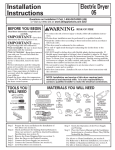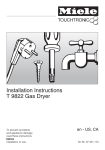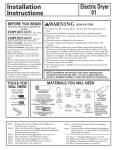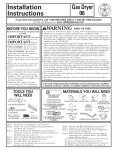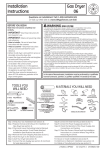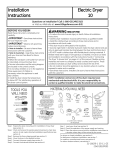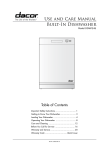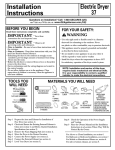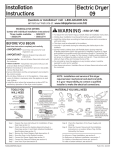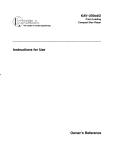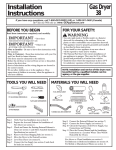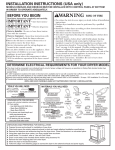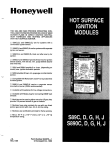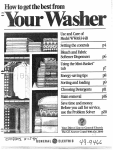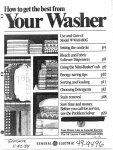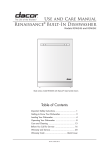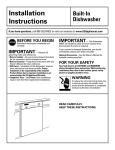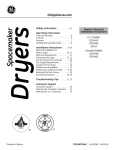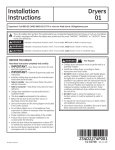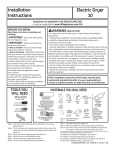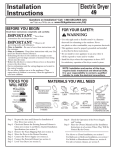Download GE DPSR610GGWT User's Manual
Transcript
Gas Dryer Installation Instructions DESIGN 06 CE R T I FIE D If you have any questions, call 1-800-GECARES (US) or 1-800-361-3400 (Canada) or Visit our Web site at: www. GEAppliances.com BEFORE YOU BEGIN Read these instructions completely and carefully. IMPORTANT• IMPORTANT- Observe all governingcodes and ordinances. • Save these instructions for local inspector’s use. • Note to Installer - Be sure to leave these instructions with the customer. • Note to Customer - Keep these instructions with your Use and Care Book for future reference. • Before the old dryer is removed from service or discarded, remove the dryer door. • Inspect the dryer exhaust outlet and straighten the outlet walls if they are bent. • Service information and the wiring diagram are located in the control console. • Do not allow children on or in the appliance. Close supervision of children is necessary when the appliance is used near children. • Install the dryer where the temperature is above 50°F for satisfactory operation of the dryer control system. TOOLS YOU WILL NEED (x2) 10" ADJUSTABLE WRENCHES 8" PIPE WRENCH SLIP JOINT PLIERS LEVEL FLAT BLADE SCREWDRIVER WARNING RISK OF FIRE • To reduce the risk of severe injury or death, follow all installation instructions. • Clothes dryer installation must be performed by a qualified installer. • Install the clothes dryer according to these instructions and in accordance with local codes. In the absence of local codes, installation must comply with National Fuel Gas Code, ANSIZ223.1/NFPA 54 or the Canadian Natural Gas and Propane Installation Code, CSA B149.1. • California Safe Drinking Water and Toxic Enforcement Act This act requires the governor of California to publish a list of substances known to the state to cause cancer, birth defects or other reproductive harm and requires businesses to warn customers of potential exposure to such substances. Gas appliances can cause minor exposure to four of these substances, namely benzene, carbon monoxide, formaldehyde and soot, caused primarily by the incomplete combustion of natural gas or LP fuels. Properly adjusted dryers will minimize incomplete combustion. Exposure to these substances can be minimized further by properly venting the dryer to the outdoors. • This dryer must be exhausted to the outdoors. • Use only 4” rigid metal ducting for exhausting the clothes dryer to the outdoors. • DO NOT install a clothes dryer with flexible plastic ducting materials. If flexible metal (semi-rigid or foil-type) duct is installed, it must be UL-listed and installed in accordance with the instructions found in "Connecting The Dryer To House Vent" on page 6 of this manual. Flexible ducting materials are known to collapse, be easily crushed, and trap lint. These conditions will obstruct dryer airflow and increase the risk of fire. • Do not install or store this appliance in any location where it could be exposed to water and or weather. • Save these instructions. (Installers: Be sure to leave these instructions with the customer). In the state of Massachusetts, installation must be performed by a qualified or licensed contractor, plumber, or gasfitter qualified or licensed by the state. MATERIALS YOU WILL NEED 4" DIA. METAL DUCT (RECOMMENDED) PIPE 4" DIAM METAL ELBOW EXHAUST HOOD COMPOUND SOAP SOLUTION FOR LEAK DETECTION 4" DIA. FLEXIBLE METAL (SEMI-RIGID) UL LISTED TRANSITION DUCT (x2) (IF NEEDED) KIT WX08X10077 (INCLUDES 2 ELBOWS) 4" DUCT CLAMPS DUCT TAPE SAFETY GLASSES OR 4" SPRING CLAMPS 4" DIA. FLEXIBLE METAL (FOIL TYPE) UL LISTED TRANSITION DUCT (IF NEEDED.) Step 1 Verify Your Gas Installation (see section 2). Step 2 Prepare the Area and Exhaust for Installation of New Dryer (see section 1). Step 3 Check and Insure the Existing External Exhaust is Clean (see section 1) and Meets Attached Installation Specifications (see section 6). Step 4 Remove the Foam Shipping Pads (see section 1). Step 5 Move the Dryer to the Desired Location. Step 6 Level Your Dryer (see section 8). Step 7 Connect the Gas Supply (see section 3) and check for leaks (see section 4). (x2) FLEXIBLE GAS LINE CONNECTOR GLOVES Step 8 Connect the External Exhaust (see section 7). Step 9 Connect the Power Supply (see section 5). Step 10 Check the Operation of the Power Supply, Gas Connections, and Venting. Step 11 Place the Owners Manual and the Installation Instructions in a Location Where They Will Be Noticed By the Owner. For Alcove or Closet Installation see section 9. For Bathroom or Bedroom Installation see section 10. For Mobile or Manufactured Home see section 11. Installation Instructions Minimum Clearance Other Than Alcove or Closet Installation Minimum clearance to combustible surfaces and for air opening are: 0 in. clearance both sides and 1 in. rear. Consideration must be given to provide adequate clearance for proper operation and service. 2 GAS REQUIREMENTS 1 PREPARING FOR INSTALLATION OF NEW DRYER WARNING TIP: Install your dryer before installing your washer. This will allow better access when installing dryer exhaust. • Installation must conform to local codes and ordinances, or in their absence, the NATIONAL FUEL GAS CODE, ANSI Z223. • This gas dryer is equipped with a Valve & Burner Assembly for use only with natural gas. Using conversion kit WE2 5X0217, your local service organization can convert this dryer for use with propane (LP) gas. ALL CONVERSIONS MUS T BE MADE BY PROPER LY TRAINED AND QUALIFIED PER SONNEL A ND IN A CCORDANCE WITH LOCAL CODES AND ORDINANCE REQUIREMENTS. • The dryer must be disconnected from the gas supply piping system during any pressure testing of that system at a test pressure in excess of 0.5 PSI (3.4 KPa). • The dryer must be isolated from the gas supply piping system by closing the equipment shut-off valve during any pressure testing of the gas supply piping of test pressure equal to or less than 0.5 PSI (3.4 KPa). DISCONNECTING GAS TURN GAS SHUT-OFF VALVE TO THE OFF POSITION. DISCONNECT AND DISCARD OLD FLEXIBLE GAS CONNECTOR AND OLD TRANSITION DUCTING MATERIAL. REPLACE WITH NEW CSA(AGA) APPROVED FLEXIBLE GAS LINE CONNECTOR AND UL APPROVED TRANSITION DUCT. WARNING - NEVER REUSE OLD FLEXIBLE CONNECTORS. The use of old flexible connectors can cause leaks and personal injury. Always use new flexible connectors when installing gas appliances. DRYER GAS SUPPLY CONNECTION 2" REMOVING LINT FROM WALL EXHAUST OPENING • Remove and discard existing plastic or metal foil transition duct and replace with UL listed transition duct. 2-5/8" WALL INTERNAL DUCT OPENING 3/8" NPT MALE THREAD GAS SUPPLY NOTE: Add to vertical dimension the distance between cabinet bottom to floor. GAS SUPPLY • A 1/8-in. National Pipe Taper thread plugged tapping, accessible for test gauge connection, must be installed immediately upstream of the gas supply connection to the dryer. Contact your local gas utility should you have questions on the installation of the plugged tapping. • Supply line is to be 1/2-in. rigid pipe and equipped with an accessible shut-off within 6 ft. of, and in the same room with the dryer. • Use pipe thread sealer compoundor Teflon tape appropriate for naturalor LP gas. • You must use with this dryer a flexible metal connector listed connector ANSI Z21.24 / CSA 6.10. The length of the connect shall not exceed 3 ft. • Connect flexible metal connector to dryer and gas supply. • Open shut-off valve. CHECK THAT EXHAUST HOOD DAMPER OPENS AND CLOSES FREELY. TILT THE DRYER SIDEWAYS AND REMOVE THE FOAM SHIPPING PADS BY PULLING AT THE SIDES AND BREAKING THEM AWAY FROM THE DRYER LEGS. BE SURE TO REMOVE ALL OF THE FOAM PIECES AROUND THE LEGS. 2 Installation Instructions 3 RECONNECTING GAS Listed connector ANSI Z21.24 / CSA 6.10 FLARE NPT 1/8" NPT PIPE PLUG FOR CHECKING GAS INLET PRESSURE 3/8" NPT PIPE SIZE AT LEAST 1/2" Note: The connector and fittings are designed for use only on the original installation and are not to be reused for another appliance or at another location. Keep flare end of adaptor free of grease, oil and thread sealant. Caution: Use adapters as shown. Connector nuts must not be connected directly to pipe threads. TIGHTEN ALL CONNECTIONS USING TWO ADJUSTABLE WRENCHES. DO NOT OVERTORQUE GAS CONNECTIONS! 4 LEAK TEST TIGHTEN THE FLEXIBLE GAS LINE USING TWO ADJUSTABLE WRENCHES. 3 Installation Instructions 6 EXHAUST INFORMATION 5 ELECTRICAL CONNECTION INFORMATION WARNING - IN CANADA AND IN THE UNITED STATES, THE REQUIRED EXHAUST DUCT DIAMETER IS 4 IN (102mm). DO NOT USE DUCT LONGER THAN SPECIFIED IN THE EXHAUST LENGTH TABLE. WARNING - TO REDUCE THE RISK OF FIRE, ELECTRICAL S HOCK, AND PERSONAL INJURY: Using exhaust longer than specified length will: • Increase the drying times and the energy cost. • Reduce the dryer life. • Accumulate lint, creating a potential fire hazard. The correct exhaust installation is YOUR RESPONSIBILITY. Problems due to incorrect installation are not covered by the warranty. • DO NOT USE AN EXTENSION CORD OR AN ADAPTER PLUG WITH THIS APPLIANCE. Dryer must be electrically grounded in accordance with local codes and ordinances, or in the absence of local codes, in accordance with the NATIONAL ELECTRICAL CODE, ANSI/NFPA NO. 70. Remove and discard existing plastic or metal foil transition duct and replace with UL listed transition duct. ELECTRICAL REQUIREMENTS The MAXIMUM ALLOWABLE duct length and number of bends of the exhaust system depends upon the type of duct, number of turns, the type of exhaust hood (wall cap), and all conditions noted below. The maximum duct length for rigid metal duct is shown in the table below. This appliance must be supplied with 120V, 60Hz, and connected to a properly grounded branch circuit, protected by a 15- or 20amp circuit breaker or time-delay fuse. If electrical supply provided does not meet the above specifications, it is recommended that a licensed electrician install an approved outlet. EXHAUST LENGTH RECOMMENDED MAXIMUM LENGTH WARNING - THIS DRYER IS EQUIPPED A THREE-PRONG (GROUNDING) PLUG FOR YOUR PROTECTION AGAINST SHOCK HAZARD AND SHOULD BE PLUGGED DIRECTLY INTO A PROPERLY GROUNDED THREE-PRONG RECEPTACLE. DO NOT CUT OR REMOVE THE GROUNDING PRONG FROM THIS PLUG. Exhaust Hood Types Use only for short Recommended run installations 4" DIA. 4" DIA. 4" DIA. 4" No. of 90º Elbows 0 1 2 3 2-1/2" Rigid Metal Rigid Metal 90 Feet 60 Feet 45 Feet 35 Feet 60 Feet 45 Feet 35 Feet 25 Feet EXHAUST SYSTEM CHECK LIST HOOD OR WALL CAP • Terminate in a manner to prevent back drafts or entry of birds or other wildlife. • Termination should present minimal resistance to the exhaust air flow and should require little or no maintenance to prevent clogging. • Never install a screen in or over the exhaust duct.This could cause lint build up. • Wall caps must be installed at least 12 in. above ground level or any other obstruction with the opening pointed down. ENSURE PROPER GROUND EXISTS BEFORE USE. SEPARATION OF TURNS For best performance, separate all turns by at least 4 ft. of straight duct, including distance between last turn and exhaust hood. TURNS OTHER THAN 90º • One turn of 45º or less may be ignored. • Two 45º turns should be treated as one 90º turn. • Each turn over 45º should be treated as one 90º turn. IF LOCAL CODES PERMIT, AN EXTERNAL GROUND WIRE (NOT PROVIDED), WHICH MEETS LOCAL CODES, MAY BE ADDED BY ATTACHING TO THE GREEN GROUND SCREW ON THE REAR OF THE DRYER, AND TO A GROUNDED METAL COLD WATER PIPE OR OTHER ESTABLISHED GROUND. SEALING OF JOINTS • All joints should be tight to avoid leaks. The male end of each section of duct must point away from the dryer. • Do not assemble the ductwork with fasteners that extend into the duct. They will serve as a collection point for lint. • Duct joints can be made air and moisture-tight by wrapping the overlapped joints with duct tape. • Horizontal runs should slope down toward the outdoors ½ inch per foot 4 INSULATION Duct work that runs through an unheated area or is near air conditioning should be insulated to reduce condensation and lint build-up. Installation Instructions 7 EXHAUST CONNECTION STANDARD REAR EXHAUST (Vented above floor level) WARNING - TO REDUCE THE RISK OF FIRE OR PERSONAL INJURY: ELBOW HIGHLY RECOMMENDED • This clothes dryer must be exhausted to the outdoors. • Use only 4” rigid metal ducting for the home exhaust duct. • Use only 4” rigid metal or UL-listed flexible metal (semi-rigid or foil-type) duct to connect the dryer to the home exhaust duct. It must be installed in accordance with the instructions found in “Connecting The Dryer To House Vent” on page 6 of this manual. • Do not terminate exhaust in a chimney, a wall, a ceiling, gas vent, crawl space, attic, under an enclosed floor, or in any other concealed space of a building. The accumulated lint could create a fire hazard. • Never terminate the exhaust into a common duct with a kitchen exhaust system. A combination of grease and lint creates a potential fire hazard. • Do not use duct longer than specified in the exhaust length table. Longer ducts can accumulate lint, creating a potential fire hazard. • Never install a screen in or over the exhaust duct. This will cause lint to accumulate, creating a potential fire hazard. • Do not assemble ductwork with any fasteners that extend into the duct. These fasteners can accumulate lint, creating a potential fire hazard. • Do not obstruct incoming or exhausted air. • Provide an access for inspection and cleaning of the exhaust system, especially at turns and joints. Exhaust system shall be inspected and cleaned at least once a year. RECOMMENDED CONFIGURATION TO MINIMIZE EXHAUST BLOCKAGE. ELBOW HIGHLY RECOMMENDED NOTE: ELBOWS WILL PREVENT DUCT KINKING AND COLLAPSING. 8 LEVELING DRYER LEVEL FRONT-TO-BACK. THIS DRYER COMES READY FOR REAR EXHAUSTING. IF SPACE IS LIMITED, USE THE INSTRUCTIONS IN SECTION 9 TO EXHAUST DIRECTLY FROM THE SIDES OR BOTTOM OF THE CABINET. LEVEL SIDE-TO-SIDE. STANDARD REAR EXHAUST (Vented at floor level) FOR STRAIGHT LINE INSTALLATION, CONNECT THE DRYER EXHAUST TO THE EXTERNAL EXHAUST HOOD USING DUCT TAPE OR CLAMP. CSA (AGA) APPROVED NEW FLEXIBLE GAS LINE CONNECTOR GAS EXTERNAL INLET DUCT PIPE OPENING 4 LEVELING LEGS DUCT TAPE OR DUCT CLAMP 4" METAL DUCT (CUT TO PROPER LENGTH) STAND THE DRYER UPRIGHT NEAR THE FINAL LOCATION AND ADJUST THE 4 LEVELING LEGS TO MATCH THE HEIGHT OF YOUR WASHER. ADJUST THE 2 ANTI-TIP LEGS TO CONTACT THE FLOOR. DUCT TAPE OR DUCT CLAMP NOTE: WE STRONGLY RECOMMEND SOLID METAL EXHAUST DUCTING. HOWEVER, IF FLEXIBLE DUCTING IS USED IT MUST BE UL-LISTED METAL NOT PLASTIC. 5 2 ANTI-TIP LEGS Installation Instructions CONNECTING THE DRYER TO HOUSE VENT DON’T RIGID METAL TRANSITION DUCT • For best drying performance, a rigid metal transition duct is recommended. • Rigid metal transitions ducts reduce the risk of crushing and kinking. DO NOT SIT DRYER ON FLEXIBLE EXHAUST. DO NOT USE EXCESSIVE EXHAUST LENGTH UL-LISTED FLEXIBLE METAL (SEMI-RIGID) TRANSITION DUCT • If rigid metal duct cannot be used, then UL-listed flexible metal (semi-rigid) ducting can be used (Kit WX08X10077). • Never install flexible metal duct in walls, ceilings, floors or other enclosed spaces. • Total length of flexible metal duct should not exceed 8 feet (2.4m). • For many applications, installing elbows at both the dryer and the wall is highly recommended (see illustrations below). Elbows allow the dryer to sit close to the wall without kinking and or crushing the transition duct, maximizing drying performance. • Avoid resting the duct on sharp objects. DO NOT CRUSH FLEXIBLE EXHAUST AGAINST WALL. 9 ALCOVE OR CLOSET INSTALLATION • If your dryer is approved for installation in an alcove or closet, it will be stated on a label on the dryer back. • The dryer MUST be vented to the outdoors. See the UL-LISTED FLEXIBLE METAL (FOIL-TYPE) TRANSITION DUCT • In special installations, it may be necessary to connect the dryer to the house vent using a flexible metal (foiltype) duct. A UL-listed flexible metal (foil-type)duct may be used ONLY in installations where rigid metal or flexible metal (semi-rigid) ducting cannot be used AND where a 4" diameter can be maintained throughout the entire length of the transition duct. • In Canada and the United States, only the flexible metal(foil-type) ducts that comply with the “Outline for Clothes Dryer Transition Duct Subject 2158A” shall be used. • Never install flexible metal duct in walls, ceilings, floors or other enclosed spaces. • Total length of flexible metal duct should not exceed 8 feet (2.4m). • Avoid resting the duct on sharp objects. • For best drying performance: EXHAUST INFORMATION section. • Minimum clearance between dryer cabinet and adjacent walls or other surfaces is: 0 in. either side 3 in. front and rear • Minimum vertical space from floor to overhead cabinets, ceiling, etc. is 52 in. • Closet doors must be louvered or otherwise ventilated and must contain a minimum of 60 sq. in. of open area equally distributed. If the closet contains both a washer and a dryer, doors must contain a minimum of 120 sq.in. of open area equally distributed. • The closet should be vented to the outdoors to prevent gas pocketing in case of a gas leak in the supply line. • No other fuel-burning appliance shall be installed in the same closet with the dryer. 10 BATHROOM OR BEDROOM INSTALLATION 1. Slide one end of the duct over the clothes dryer outlet pipe. 2. Secure the duct with a clamp. 3. With the dryer in its permanent position, extend the duct to its full length. Allow 2” of duct to overlap the exhaust pipe. Cut off and remove excess duct. Keep the duct as straight as possible for maximum airflow. 4. Secure the duct to the exhaust pipe with the other clamp. • The dryer MUST be vented to the outdoors. See EXHAUST INFORMATION section 6. • The installation must conform with local codes or, in the absence of local codes, with the NATIONAL FUEL GAS CODE, ANSI Z223. 11 MOBILE OR MANUFACTURED HOME INSTALLATION DO • Installation must conform to the MANUFACTURED HOME ELBOW HIGHLY RECOMMENDED ELBOWS HIGHLY RECOMMENDED 6 CONSTRUCTION & SAFETY STANDARD, TITLE 24, PART 32-80 or, when such standard is not applicable, with AMERICAN NATIONAL STANDARD FOR MOBILE HOME, NO. 501B. • The dryer MUST be vented to the outdoors with the termination securely fastened to the mobile home structure. (See EXHAUST INFORMATION section 6.) • The vent MUST NOT be terminated beneath a mobile or manufactured home. • The vent duct material MUST BE METAL. • KIT 14-D346-33 MUST be used to attach the dryer securely to the structure. • The vent MUST NOT be connected to any other duct, vent, or chimney. • Do not use sheet metal screws or other refastening devices which extend into the interior of the exhaust vent. • Provide an opening with a free area of at least 25 sq. in.or introduction of outside air into the dryer room. Installation Instructions 12 DRYER EXHAUST TO LEFT OR BOTTOM CABINET ADDING NEW DUCT FIXING HOLE WARNING - BEFORE PERFORMING THIS EXHAUST INSTALLATION, BE SURE TO DISCONNECT THE DRYER FROM ITS ELECTRICAL SUPPLY. PROTECT YOUR HANDS AND ARMS FROM SHARP EDGES WHEN WORKING INSIDE THE CABINET. BE SURE TO WEAR GLOVES PORTION "A" LEFT SIDE EXHAUST Reconnect the cut portion (A) of the duct to the blower housing. Make sure that the shortened duct is aligned with the tab in the base. Use the screw saved previously to secure the duct in place through the tab on the appliance base. REMOVE SCREW AND SAVE. ADDING ELBOW AND DUCT FOR EXHAUST TO LEFT SIDE OF CABINET REMOVE DESIRED KNOCKOUT (ONE ONLY). • Preassemble 4" elbow with 4" duct. Wrap duct tape around joint. • Insert duct assembly, elbow first, through the side opening and connect the elbow to the dryer internal duct. CAUTION: Be sure not to pull or damage the electrical wires inside the dryer when inserting the duct. Detach and remove the bottom or left side knockout as desired. Remove the screw inside the dryer exhaust duct and save. Pull the duct out of the dryer. FIXING HOLE B A 9" Cut the duct as shown and keep portion A. TAB LOCATION DUCT TAPE BEND TAB UP 45 o • Apply duct tape as shown on the joint between the dryer internal duct and the elbow. DUCT TAPE Through the rear opening, locate the tab in the middle of the appliance base. Lift the tab to about 45º using a flat blade screwdriver. 7 CAUTION: Internal duct joints must be secured with tape, otherwise they may separate and cause a safety hazard. Installation Instructions 13 CHANGING DIRECTION OF DOOR OPENING ADDING ELBOW FOR EXHAUST THROUGH BOTTOM OF CABINET • Insert the elbow through the rear opening and connect it to the dryer internal duct. • Apply duct tape on the joint between the dryer internal duct and elbow, as shown on page 7. REMOVE 4 HINGE SCREWS. REMOVE 4 HOLE PLUGS AND PLACE THEM IN THE HOLES ON THE OPPOSITE SIDE. CAUTION: Internal duct joints must be secured with tape, otherwise they may separate and cause a safety hazard. ADDING COVER PLATE TO REAR OF CABINET ROTATE DOOR 180 0 AND REINSTALL. PLATE (KIT WE1M454) PLATE (KIT WE1M454) Connect standard metal elbows and ducts to complete the exhaust system. Cover back opening with a plate (Kit WE1M454) available from your local service provider. Place dryer in final location. WARNING - NEVER LEAVE THE BACK OPENING WITHOUT THE PLATE. 14 SERVICING WARNING - LABEL ALL WIRES PRIOR TO DISCONNECTION WHEN SERVICING CONTROLS. WIRING ERRORS CAN CAUSE IMPROPER AND DANGEROUS OPERATION AFTER SERVICING/INST ALLATION. TO REGISTER YOUR DRYER CALL TOLL-FREE 1-888-269-1192 Prompt registration confirms your right to protection under the terms of your warranty. For replacement parts and other information, refer to Owner's Manual for servicing phone numbers. www.GEAppliances.com For Questions on Installation, Call: 1-800-626-2000 (US) or Pub. 31-16225 1-800-561-3344 (Canada). Pub.##31-15476 500A436P006 8








